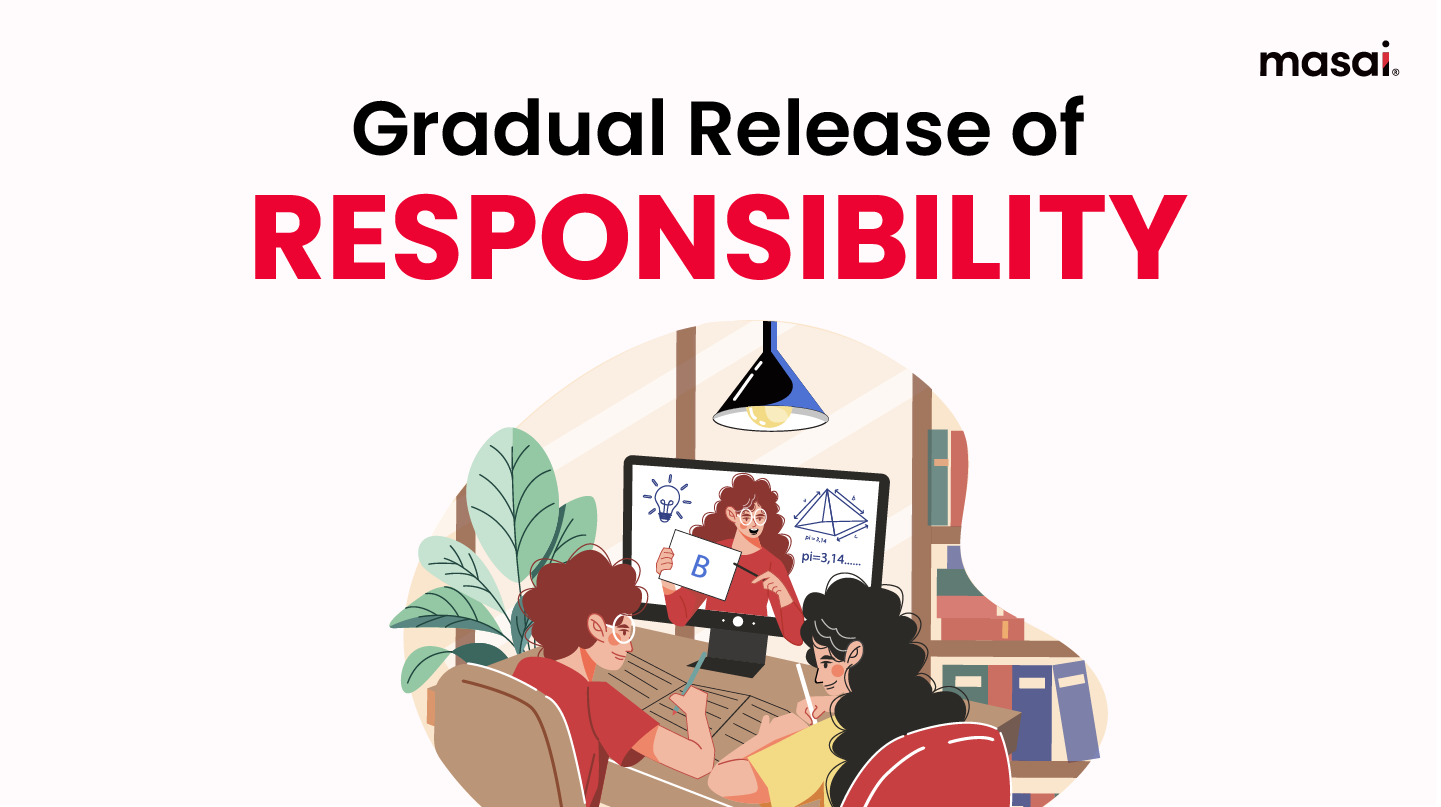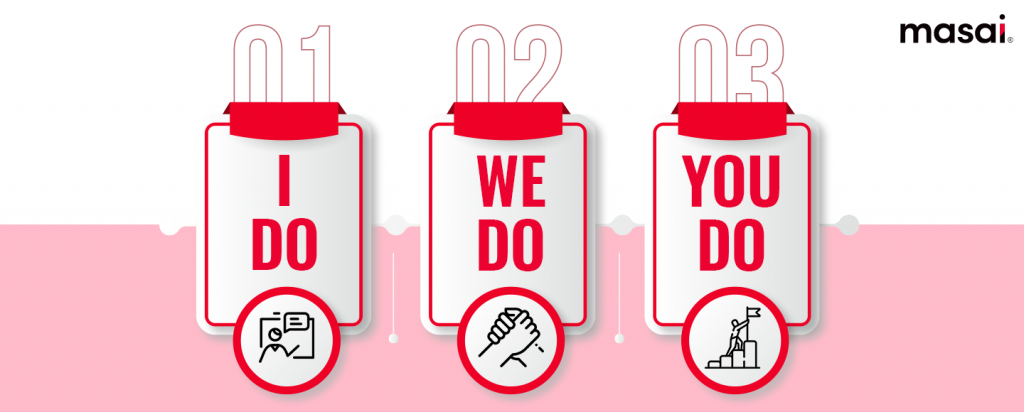Understanding the I-do, We-do, You-do teaching pedagogy
A study by Conklin and Wilkins among elementary students showed great improvement in their reading levels while taking the ‘We do’ approach. And once they were able to read properly, they enriched their vocabulary and oral language skills as well.

Have you ever observed how a bird trains their chicks to fly?
To begin with, they fly around the nest as the chicks watch. This live example setting goes on for a while until the mother bird asks her babies to follow along. The babies practice flying with their mother for a fair amount of time. Meanwhile, the mother looks for any shortcomings or flaws in their technique and corrects them if needed. Lastly, when the mother is confident enough, she sends her kids to fly alone as she observes from the nest. They keep practising until they’ve mastered the skill of flying and they don’t ever forget this lesson throughout their lives.
This is at the core of the ‘I Do-We Do-You Do’ method of learning also called the ‘Gradual release of responsibility. It is a teaching pedagogy that focuses on the transfer of responsibility from the teacher to a student while learning, up until the point where the student becomes absolutely independent and can do the required tasks on their own.
IWY is an effective and proven method for helping students to learn and master new skills, all the while gradually building confidence in them.
As a result, we get a confident learner who directs their learning through their own cognitive function and who doesn’t shy away from taking up newer, more complicated work.
How does Gradual Release of Responsibility work?
The IWY or GRR methodology involves these three steps necessary for the overall development of a student :
- Modelled/Direct Instruction
- Guided Instruction
- Independent tasks

Let’s understand each of them in detail –
Modelled Instruction (I Do)
Being the first phase of the GRR framework, modelled instruction lays the foundation for all learnings. It is where the instructor models themselves to solve a particular problem and the students are expected to observe attentively and grasp the concepts.
It should be noted that the students aren’t given any added burden and they just have to watch the instructor performing the practical steps with a crystal clear mind.
The instructor follows a systematic sequence in providing a detailed demonstration of the concept.
- Stating the purpose of the task
- Explaining when and where it is used
- Referring to analogies linking previous knowledge to the new concept
- Show how the task is completed at their own pace
- Addressing the key steps and errors to avoid
At Masai, this session usually runs for 30-40 minutes where students take live notes from the presentation and they can also ask for more clarification in certain steps. Upon watching a live demonstration, they get a deeper understanding of what to do, how to apply it, when to apply it, and how to analyse their results. Providing students with examples is the best way to start the lesson and arouse curiosity for further learning.
Guided Instruction (We Do)
This is the phase where the instructors start releasing responsibility onto students. ‘We do’ means both the instructor and the students perform the task together using the concepts defined for key objectives.
The key to the ‘We do’ phase of learning is scaffolding.
But what is it?
Scaffolding is the process of using a temporary structure(wooden planks and poles) on the outside of a building during construction.
Using the same principle, students are provided support with faded and incomplete worked examples whereby the instructor guides them by completing some of the steps and the students are expected to complete the remaining steps.
This phase is really significant and is often ignored in our regular learning methods. Even after modelling, students aren’t completely acquainted with the concepts and thus they need guided step by step instruction while performing the task.
Example:- Name the biggest land carnivore in South America.
Some of you might know this and some of you might not.
But if I use this-
| J | A | U | R |
The majority of you would get it.
(For those who’re still wondering, it’s a jaguar)
That’s how scaffolding works in the IWY method.
A study by Conklin and Wilkins among elementary students showed great improvement in their reading levels while taking the ‘We do’ approach. And once they were able to read properly, they enriched their vocabulary and oral language skills as well. (Source – Wikipedia).
This went on to show that making little changes in the approach to learning can garner long term success for students.
And that’s why the Masai team focuses on differentiated learning. Usually, the ‘We Problem Set’ runs for 40-60 minutes for each lesson as the instructor takes the students along in solving the problem.
Independent Practice (You Do)
Now that the students have observed the live example and have also completed the task with the instructor, it’s time that they are assigned full responsibility and do the task independently. This is where the ‘You do’ phase starts.
Students employ what they’ve learned in new assignments, while the instructor circulates the room to see if students are facing any difficulty in certain areas. If they find a common area of concern among a group of students, they interact with the group and guide them until the problem is solved. Students with no problem areas proceed with their tasks.
The goal here is to practise new projects on their own based on the same concept in order to be able to master it.
By the end of this phase, a student develops self-reliability, confidence and is able to pull off tasks even in the most pressured situations.
Credit to the IWY method, Masai students end up coding for more than 1000-1200 hours, completing 100s of assignments during the entirety of the course.
That might sound improbable but guess what, the right approach to learning can truly do wonders.
On that note, let’s look at a few benefits, and the impact this model can have on a student’s life.
Benefits of the I Do-We Do-You Do Model
Needless to say, this model has numerous advantages over the traditional teaching methods and we’ll discuss a few of them here:
- The IWY method makes for a more collaborative and team-oriented learning. There are ample student-instructor, and peer-to-peer interactions among the group which result in learning a concept in and out from different perspectives thus creating a mind-map of the concept.
- Learning with a gradual shift of responsibility reduces task anxiety in students and makes studying a fun thing. There is proper time and space given to students to transition from a beginner to an independent performer.
- One of the most important benefits of this model is that it allows inclusivity. Meaning? Students from diverse backgrounds can grasp concepts with ease due to the step-by-step guidance.. The instructors analyse which stage a particular student is at, where they’re facing problems, and provide support accordingly. They might also group like-minded students together and conduct separate sessions with them so that students with similar problems don’t feel left out and thus creating more student interactions.
- As we have discussed earlier, students gain tremendous self-confidence and leadership skills as they go through three phases of learning and are aware of the journey from a novice to complete independence. In short, they know how it feels and they have the much needed self-belief for learning anything new that comes their way.
Gradual Release of Responsibility at Masai
Becoming a Software developer in 7 months is no easy feat. It requires effort from both students and the team. More importantly, it requires advanced teaching strategies like the GRR which comes with a systematic and organised approach to focused learning over a 7 month period.
Learning under the I Do-We Do-You do model, students at Masai work on 4-5 different projects as teams which further enhances their collaborative skills and sets them up beautifully for real-world projects at big companies.
(Want to check out a few projects that our students have created? – Construct week)
In addition to the instructors, we have instructional associates(IA) for each session to help students whenever needed. This instructor-IA partnership makes it easier for students to express even their minute doubts without disturbing the progress of other students.
IWY is one of the important pillars on which the success of Masai’s students depends upon along with Mastery-Based Progression.
Who would believe that students from commerce and other far fetched non-tech backgrounds can get high-end jobs as software engineers?
We make it possible because we believe in our methods, in our empathetic style of teaching that’s customised for everyone, be it a beginner or an intermediate.
(Here’s Ayushi Shah talking about her journey from a finance intern to a software developer at ShareChat)

